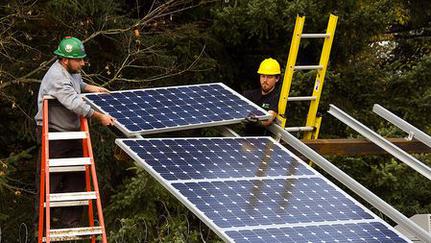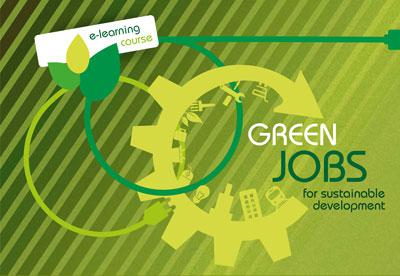GreenLivingMostWanted.com
Education - Issues - Strategies - Solutions - Resources
GREEN LIVING CAREERS & JOBS
In today's economy, green jobs are growing. Take advantage of this up-and-coming trend.
Although the current economic climate seems to be consistently cloudy, there’s reason to be hopeful for some sunshine: according to the new report published by Clean Edge, Inc. in partnership with Green America, there are several trends that suggest a bright outlook for green jobs in the future.
“We believe this [economic] crisis can accelerate the transition to a clean-energy economy, with the creation of millions of new jobs in a wide range of clean-tech sectors,” the report, Clean Tech Job Trends 2009, states.
With a number of people soon retiring from the workforce, growing concern about the high cost of energy, and green career training programs popping up across the country, there is more and more opportunity for people interested in greening their work.
The report focuses on clean-tech jobs—which utilize technology related to renewable energy, energy efficiency, and pollution reduction—but the trends are applicable to green jobs across the board. Many other green sectors are also growing—since 2000, organic agriculture has more than doubled, according to the Worldwatch Institute, and the Fairtrade Federation reports that Fair Trade sales worldwide increased 22 percent in 2008.
If you’re looking for employment that also makes a difference in the world, there are a growing number of resources to help you take advantage of these positive green job trends.
What is a Green Job?
Before you start your journey to find a green job, it’s important to know what to look for. A green job is any job that supports environmental and social responsibility.
This includes solar panel installers and engineers, organic landscapers, holistic health care providers, advocates for social justice and poverty reduction, socially responsible investment advisors, community organizers, and more.
In addition to focusing on environmental sustainability, green jobs are often financially sustainable. Many of them—especially clean tech—are jobs that “pay well and provide job security,” says Todd Larsen, Green America’s director of corporate responsibility. They pay well because they require specialized skills, and they’re secure because many of the jobs can’t be outsourced overseas. As the clean tech report explains, it’s more cost-effective to manufacture products like wind turbines close to where they’ll be used, because of shipping costs due to the sheer size. Plus, jobs like retrofitting buildings to be more energy efficient must be done where the building is physically located.
Where Do I Start?
There are many resources to assist you in finding a green job. The clean tech report lists the leading resources for green-job seekers in an index. Whether you’re new to the job market or are looking for a change of pace, there’s a tool out there to help you snag a green job.
Educational Opportunities Abound
Now is the perfect time to take advantage of college courses or training programs related to green jobs. In addition to the growing need for these jobs, many current employees—especially in the energy sector—will retire soon, according to the Clean Edge report. With so many people leaving the workforce while so much technological advancement is taking place, it’s the perfect time for job seekers to learn new green skills. Career training and educational opportunities are blossoming, even in the face of an economic crisis.
“Education booms when the economy goes bust, so this is a great time to go back to school and retool for the future,” says Jill Bamburg, a co-founder of the Bainbridge Graduate Institute (BGI) and author of Getting to Scale: Growing your Business without Selling Out (Berrett-Koehlerm, 2006). Here are some different educational opportunities that will put you on the path to a greener career:
• College degrees: Check out local community or four-year colleges, or graduate schools for green programs of study that interest you. These could range from sustainable agriculture to wind energy to green business degrees. Colleges like BGI also offer students a great network for finding a job after graduation, as well as what Bamburg calls “credential”—proof you are serious about green employment.
“The credential is a door-opener—something that appears on your resume and indicates that your interest in doing ‘green’ things has gone beyond the talking stage,” says Bamburg. “You’ve actually pursued training to make yourself useful to an employer—and it gives you something to talk about in an interview.”
Whether you’re headed to college or grad school for the first time, or going back to learn new skills and information, you’ll be ahead of the game by focusing your education on an environmentally and socially responsible career.
“Many of our students are mid-career professionals or people who are looking for a second career that is more aligned with their values than their first career was. They simply add their new sustainable business skills and credential to the rest of their resume,” says Bamburg. “Our program, like many programs out there, is specifically designed to fit the scheduling requirements of working adults.”
RESOURCES: See below a list of colleges with a sustainability focus that are approved Green America Business Network™ members, and consult the “Education” category of our GreenPages.org Web site.
• Certifications & training programs: Whether you’re new to the workforce or a seasoned vet, certifications and training programs are valuable resources, and they are especially prominent and necessary in the energy sector. People are growing more concerned about high energy costs, according to the clean tech report, so energy efficiency is a major priority for many people.
When you complete a certification or training program, you learn skills directly related to energy efficiency and sustainability. You might learn how to install a solar panel, how to reuse or salvage construction materials, or how to sell a house and emphasize positive environmental attributes. There are plenty of sectors where knowledge about energy efficiency is becoming essential, so these programs are especially great for people who want to take a green step forward in their jobs.
RESOURCES: In addition to the Clean Edge report, visit Green for All’s Web site, and scroll down to the “certified job training” and “sector specific training and certifications” for links to training and certification resources across the US.
• Apprenticeships: On-the-job training is a great way to learn skills, and there are many apprenticeships available across the country.
RESOURCES: Visit www.doleta.gov/OA/sainformation.cfm to search for apprenticeships by state, and look for apprenticeships that support environmental sustainability and social justice.
On the Job Hunt
As the green job market grows, more job fairs, job boards, Web sites, and career centers are offering guidance toward green jobs. Here are some leading green job resources:
• Job Boards: There are many web sites devoted to green jobs including:
Websites like www.idealist.org are also full of nonprofit jobs that support sustainability and social justice.
• Career centers: One-stop career centers offer a comprehensive set of resources for all job seekers. At these centers, people can access a variety of work-related resources: resume writing guides, career counseling, the Internet and telephones, employer referrals, and more. You can meet with a representative at the center to talk about and strategize how to accomplish green career goals.
RESOURCES: Visit www.careeronestop.org for more information, and www.servicelocator.org to find local career centers. Also, try contacting a green career-consulting firm like Green Career Central, Green Career Tracks, or the Center for Meaningful Work to help you on your quest for a green job.
• Networking: A great way to get your foot in the door toward a green job is through networking. Key networking avenues are job fairs and green-job conferences, where you can meet employers and learn more about green jobs, and networking and social media Web sites, where you can connect with people online in the green marketplace.
Don’t be afraid to contact people even if they can’t give you a job—having a quick chat with someone from a business or nonprofit you like could provide valuable information and contacts. “Call [an employer] and say, ‘I really admire what your company does, and I know you don’t have job openings, but would you be free for coffee to talk for 20 minutes?’” suggests Todd Larsen.
This kind of informational interview could lead you to green job resources and possibilities.
• Volunteering is another great way to get acquainted with and make contacts in different green job sectors; prove yourself as a reliable, hard-working employee for possible job openings in the future; and help organizations support worthwhile causes.
RESOURCES: LinkedIn.com is a great social networking tool for job seekers who want to connect with people in the green job world. Aside from posting your professional experience for prospective employers to see, you can join LinkedIn groups specific to green jobs, such as: Green Jobs & Career Network, Cool Climate Jobs, Clean/Green Opportunity, Clean Edge Jobs, and Green Energy and Sustainability Careers and Jobs. LinkedIn allows job seekers to find employers, employers to search for possible employees, and people to make contacts in the green business world and learn more about green jobs.
The Good Jobs, Green Jobs conference will be held in Washington, DC, on May 4–6, 2010. This national conference features a Green Jobs Expo that “showcases the many paths to green jobs and careers.”
Also check out www.greenjobs.net/green-job-fairs/ for a list of green job fairs held across the country. College campuses are popular places for job fairs, so check with your local community or four-year college to see when the next job fair will be. Job fairs don’t have to specifically be “green” for you to find plenty of jobs that fit the category.
Visit www.idealist.org or www.volunteermatch.org to search for volunteer opportunities in your area.
Green Your Current Job
If you want a job that supports sustainability and social justice but don’t want to leave your current career, then green your current job instead of looking for a new one. Or, if you own a business, try greening that, too.
“It’s important to know you can do almost anything in a green way,” says Larsen. “There’s clothing that’s green, house cleaning that’s green, investors that are green—whatever your skills are, there are things anyone can do to contribute to a greener workplace.”
Whether it’s working to increase your workplace’s energy efficiency, starting a carpool at work, or looking at the core business and trying to make it more environmentally and socially responsible, you can also take steps in your current job to make it and your workplace greener.
GETTING A GREEN JOB
Get Your Green Dream Job
Between 1998 and 2007, the green economy grew three times faster than the rest of the economy in the same period. Most of the job growth occurred in the renewable energy sector. Even during the recent recession, Brookings found that the clean economy outperformed the nation. Buffered somewhat through the recession and enjoying higher salaries, those working in the green economy have a bright future.
Do you have a passion for environmental issues? Do you want to be a part of the growing green economy but don’t know where to start? Here are some tips for getting a green job:
Assess your skills. What are you good at? What do you have training in? Sustainability is beginning to permeate every industry, meaning that you might not have to shift gears so drastically to get the job you want. If you work in fundraising, perhaps you can apply your expertise to an environmental organization, for example. Working in the building trades? Get LEED certified or trained to install solar panels or conduct energy retrofits.
Surf the job search sites. There are lots of great websites devoted solely to green job opportunities. Check out Idealist, Grist’s Green Jobs Board, Orion Grassroots Job Source, Treehuggerjobs, GreenJobs.com, EcoEmploy,
Renewable Energy World, and sustainablebusiness.com. Most large private, government and nonprofit organizations also let you sign up for job alerts when new positions are posted through RSS feeds or email. Interested in working for an environmental or conservation nonprofit? Many of EarthShare’s member organizations offer career opportunities on their websites.
Go social. Social media can be a great way to follow news about the green economy and find job opportunities. If you’re on Twitter, follow @GristJobs, @EnvironmentJob, and @greenerjobs for job alerts and @EDFbiz, @GreenBiz and @GuardianSustBiz for information on the green economy. And follow EarthShare’s Pinterest board for news and infographics about sustainability in the office.
Network. Face-to-face connections are usually much more effective than electronic communication. Set up informational interviews with people in the field you’d like to work in and get a sense of the job market and skills required. Visit conferences that draw together professionals in your industry and start schmoozing! Some relevant annual conferences include Good Jobs, Green Jobs; RETECH and Greenbuild. CSRwire maintains a calendar of sustainability-focused events—find one in your area.
Do a green retrofit on your existing job. Don’t find it feasible to jump ship in a tough economy? Virtually any employee can push for sustainable changes in their existing organizations. Try joining or starting a green team to share ideas with colleagues and build will for solutions at your company.
1. Use your strengths
Do you know you want to get started on a green career path but aren’t sure how? Resist the urge to start from scratch with a brand new career, DiRamio suggests. Instead, assess the strengths, skills and knowledge you already have and go from there.
“I think there’s a little bit of a problem with thinking about ‘green jobs’ as entirely new jobs…that you need new training in,” DiRamio says. “Often most of the skills that you need for a job that’s conserving energy or resources or reducing pollution are in traditional industries.”
If you already have a technical skill or are experienced in a certain industry, think about ways you could use your experience to help the environment. For example, if you work in construction, a career in energy efficiency retrofits or deconstruction projects may be for you. If you’re an electrician, you’ll likely require minimal training for a career in solar panel installation.
Making the most of your skills and experience lessens the stress that often comes with a big career change. It also helps you make the switch more easily and quickly, as you may only need a few classes to “green” your skills, as opposed to several years of training in a brand new field.
If you’re still in school, unemployed or craving a dramatic career change, you’ll probably need a fair amount of training before embarking on your new green career. Do your research first to find out how much time and money it will take to get the training you need, and use that information to decide whether or not the field you chose is right for you.
2. Know the market
Understanding trends and current events is a big part of making your career switch successful. Read up on national green jobs reports, like the recent “Sizing the Clean Economy: A National and Regional Green Jobs Assessment” from the Brookings Institution to stay informed on the number of new green jobs, the industries where green jobs are most needed and the market demand overall, suggests DiRamio.
But don’t get too hung up on national statistics. As the Brookings Institution report shows, every region has a different set of strengths in the green economy – meaning job growth may be higher or lower in certain industries depending on where you call home.
“Don’t just look at the national news…Connect locally with information sources and organizations that really know the local environment, the employers in the region and that region’s strengths,” says DiRamio.
Some states, including Pennsylvania, Washington, California and Michigan, have released green jobs reports that track job growth throughout the state and project future numbers. Not sure how to track down your state’s green jobs report? A simple Web search with your state’s name and the words “green jobs report” should point you in the right direction.
INFOGRAPHIC: Where to Get a Green Job
3. Explore training resources
Whether you’re employed or not, you’ll probably need a bit of training to get you started on a career in green. While local job training centers, community colleges and universities may sound like obvious places to start, DiRamio says these choices are still the most practical.
“If [you] are already employed and want to make a change, check with a local community college or university about training resources,” suggests DiRamio.
“Community colleges and job training centers should have people working with employers, getting a sense of where the demand is for a kind of skill and making sure that the courses that are being taught are as closely tied to what employers are saying is needed,” he says.
If you are unemployed or seeking a career in an entirely new field, start with training centers that offer job placement assistance to help you get your foot in the door.
For additional resources, check out MySkillsMyFuture.org – a Department of Labor-sponsored site that matches your current or past jobs to green careers with similar skills. Once you’ve found a career match that strikes your fancy, simply type in your zip code to find training near you.
If you’re still in school, schedule an appointment with your academic advisors, and ask them about environmentally-related courses within your current major. Once you’ve narrowed your focus, start with one class to gauge your interest in the field. If you find yourself falling asleep, you may want meet with your advisors again to discuss additional options.
4. Start with your own company
Most of us picture a daunting job search when we think about making the switch to a green career. But if you’re already employed, starting within your own company is often more successful, DiRamio says.
“In my view, every job has the potential to be a ‘green job’ if we want to make it that way,” DiRamio says. “Most green jobs are in pretty traditional industries.”
Take the initiative to complete a class or two at your own expense. Then schedule a meeting with your supervisor to discuss how your growing green skill-set can help the company. This may lead to an exciting new career path for you and a more eco-friendly focus for your whole office.
“There are opportunities for people to sell their skills internally…and say ‘I learned this new skill; I think I can help us save some money,’” DiRamio says. “Everybody’s looking to save money now.”
“Take a class in something that seems directly relevant to your current occupation, think about ways it could be applied in your company and propose those ideas [to your manager],” DiRamio suggests. “Then you start to become an internal change agent within your company.”
5. Get smart about your search
If you’re unemployed or looking for a job outside of your current company, get smart about your search to avoid stress and wasted effort.
Feel out the market and find opportunities near you by searching job boards that focus on environmental or social responsibility – like EcoEmploy and GreenJobSearch.org.
To meet fellow job-seekers and professionals in the field, check out an informal Green Drinks gathering, or head to a local job fair for a little face-to-face time with potential employers.
For even more tips on finding (and landing!) your dream green job, check out Earth911′s job search guide.
CHOOSING GREEN
ECO-EMPLOYMENT
11 OF FASTEST
GROWING GREEN JOBS



















